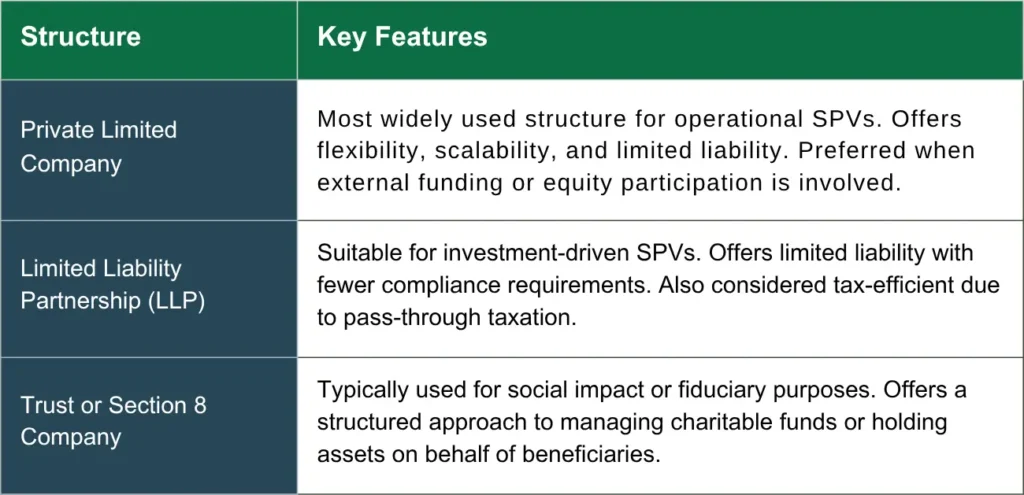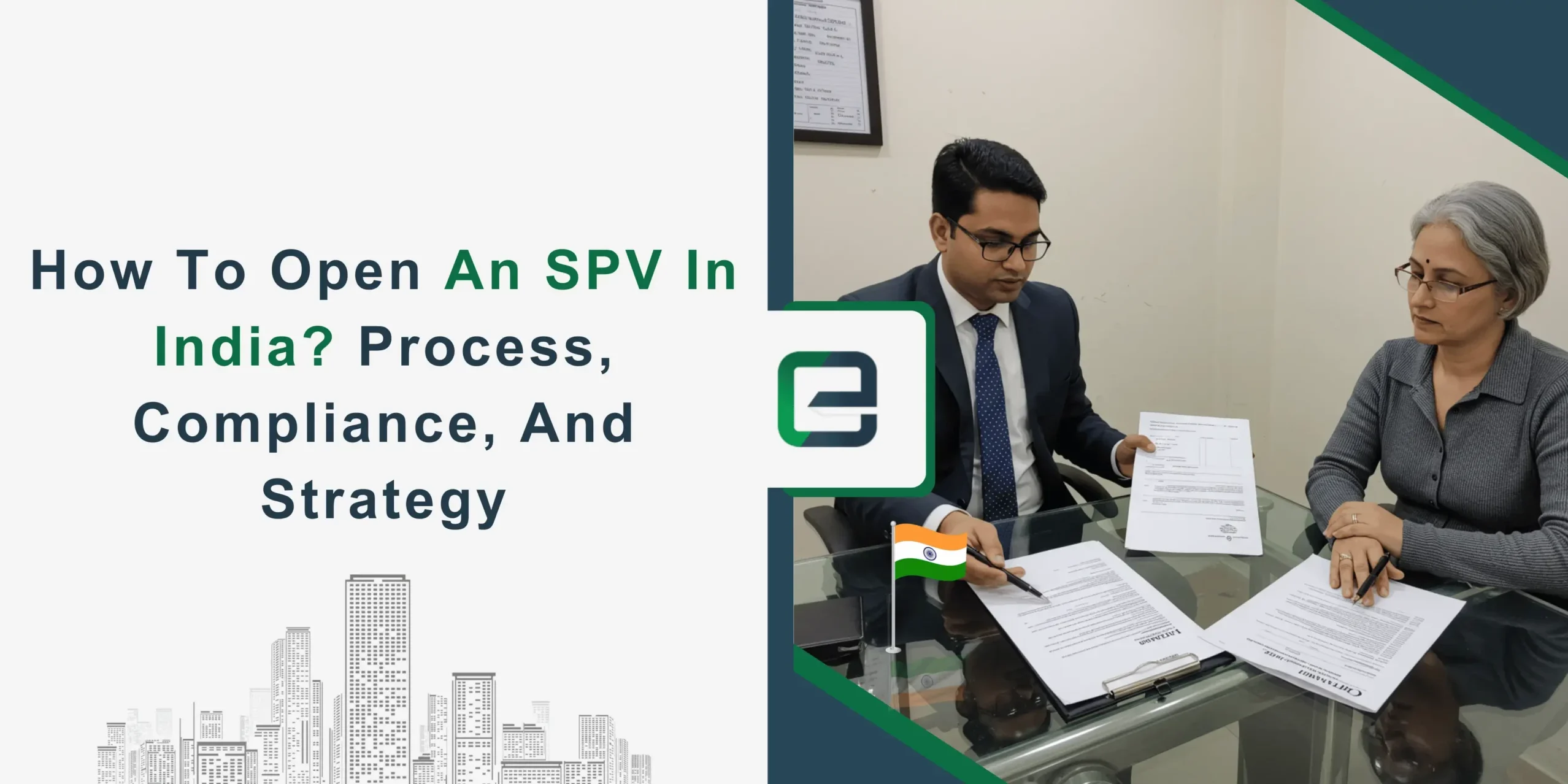Special Purpose Vehicles (SPVs) are separate legal entities created to execute specific projects or hold particular assets. Businesses use SPV companies in India to manage risk, simplify partnerships, and structure investments more efficiently. In India, SPVs are increasingly common in infrastructure, real estate, and joint ventures which offer flexibility, control, and financial clarity.
This article outlines how to establish a SPV in India, the regulatory process, and compliance considerations for setting up an SPV in India.
What is a Special Purpose Vehicle ( SPV) in India?
Special Purpose Vehicle (SPV) is a separate legal entity created by a company for a specific and limited objective. It is also known as a Special Purpose Entity (SPE).
Companies form SPVs to carry out particular projects or to hold specific assets without affecting the main business operations. SPVs help in reducing financial risk and organising business activities more efficiently.
SPVs are particularly relevant in situations where risk containment, asset securitization, or regulatory arbitrage is strategically desirable. In India, SPVs are commonly used in:
- Infrastructure projects
- Real estate and REIT structures
- Private equity and venture capital investments
- Securitization and asset leasing
- Corporate restructurings and joint ventures
Also Read: Understanding Types of Business Entities to Set Up in India
What are the Features of an SPV ?
1.Independent Legal Identity: It can own property, enter into contracts, and sue or be sued.
2.Purpose-Based: Created for a specific project or activity.
3.Limited Liability: The parent company is not fully responsible for the SPV’s losses.
4.Separate Financial Records: It maintains its own books of account.
What is the Legal Structure of an SPV?
When setting up a Special Purpose Vehicle (SPV) in India, choosing the right legal structure is crucial. The decision depends on several factors such as taxation, ease of control, funding strategy, regulatory requirements, and the overall purpose of the entity. Below is a comparative table outlining the commonly used legal structures for SPVs and their key features:

How to Set up a Private Limited SPV in India?
Here is a streamlined view of how to incorporate a Private Limited SPV in India:
Step 1: Name Reservation (RUN Application)
Apply to the Ministry of Corporate Affairs (MCA) for name approval.
Tip: Choose a name aligned with your SPV’s objective and avoid restricted or sensitive words to minimize rejections.
Step 2: Digital Signature Certificates (DSC)
All proposed directors must obtain DSCs to digitally sign incorporation documents.
Documents required: ID proof (PAN, passport), address proof (Aadhaar, utility bill), photo, and email/phone verification.
The certifying agency issues the DSC after KYC verification.
Tip: Start this step early, as DSCs are mandatory for all filings with the MCA.
Step 3: Drafting the SPV’s Charter (MoA & AoA)
Define the specific purpose of the SPV in the Memorandum of Association (MoA) and operational rules in the Articles of Association (AoA).
Documents required: Final drafts of MoA and AoA, signed by subscribers (digitally or physically as per process).
These documents are filed with the incorporation form for MCA approval.
Tip: Be precise about the SPV’s objective in the MoA, as this defines its permitted activities and helps avoid regulatory complications later.
Step 4: Filing for Incorporation (SPICe+ Form)
Submit the integrated application to the MCA, including company details, directors, registered office, and declarations.
Documents required:
- DSC of directors and subscribers
- ID and address proof of directors (PAN, Aadhaar, passport, etc.)
- Proof of registered office (utility bill + NOC from owner)
- MoA & AoA
- Declarations (INC-9, DIR-2)
The Registrar of Companies (ROC) issues the Certificate of Incorporation on approval.
Tip: Double-check details in the SPICe+ form, as errors can delay incorporation.
Step 5: PAN, TAN, and Bank Account Setup
After incorporation, apply for the SPV’s PAN and TAN to meet tax compliance requirements. Then, open a dedicated bank account to handle all project-related transactions.
Documents required (for bank account): Certificate of Incorporation, PAN, MoA, AoA, board resolution for account opening, KYC of directors.
Tip: Choose a bank experienced in handling corporate accounts to simplify operations.
Chartered Accountants or legal service providers usually assist with this. At 3E India, we streamline this step by handling registrations and ensuring your SPV is ready to operate from day one
Why is an SPV Created?
Companies form SPVs for the following reasons:
1. To manage financial risk:
If the project fails, the losses are limited to the SPV and do not impact the parent company.
This protects the parent company’s balance sheet and ensures that liabilities from one project don’t affect the entire business. It’s a common strategy in infrastructure, real estate, and high-risk ventures.
2. To carry out focused projects:
SPVs are ideal for projects that need dedicated attention, like road construction or power generation.
A separate entity allows for streamlined decision-making, resource allocation, and monitoring which is free from distractions of the core business.
3. To raise funds separately:
The SPV can borrow money or raise investment only for its specific purpose. Investors and lenders prefer SPVs because they offer transparency and a clear linkage between funding and asset/project performance.
4. To work with partners:
When two or more parties want to collaborate, an SPV offers a clear structure to work together. It defines roles, responsibilities, and profit-sharing arrangements, making joint ventures more efficient and legally sound.
What are the Advantages and Limitations of an SPV?
Setting up a Special Purpose Vehicle (SPV) can offer clear strategic benefits, but it also comes with essential challenges. A quick overview of both sides:
Advantages of SPVs
1. Reduces the risk for the main business
By isolating liabilities, an SPV protects the parent company from project-specific financial or legal exposure.
2. Makes it easier to raise money for specific projects
Investors are often more willing to fund a focused, ring-fenced entity tied to a single project.
3. Helps in better governance and control of individual projects
SPVs allow for tighter oversight, making project execution and accountability more efficient.
4. Useful for public-private partnerships (PPP)
SPVs provide a neutral structure to manage joint ownership and responsibilities in PPP initiatives.
Limitations of SPVs
1. High setup and compliance costs
Forming and maintaining an SPV requires legal, regulatory, and administrative expenses.
2. Misuse of SPVs can lead to lack of transparency
If not structured properly, SPVs can obscure ownership and financial accountability.
3. Needs careful monitoring and management
An SPV must be actively managed to ensure it stays compliant and effective.
4. Poor governance may lead to legal and financial issues
Weak internal controls can expose the SPV and its stakeholders to significant risks.
What are Some Core Considerations Before Setting up an SPV in India?
Before establishing an SPV in India, businesses must carefully assess legal, regulatory, and tax factors to ensure the entity aligns with their strategic goals. Here are some core considerations to set up an SPV in India
1. Choice of Legal Entity
In India, the most common SPV formats include
- Private Limited Company (most preferred for operational flexibility)
- Limited Liability Partnership (LLP) (used where pass-through taxation is desirable)
- Trust or Section 8 Company (used in social infrastructure or non-profit contexts)
2. Regulatory Approvals
SPVs may trigger regulatory compliance under:
- Companies Act, 2013
- Foreign Exchange Management Act (FEMA)
- Securities and Exchange Board of India (SEBI) for listed instruments
- Sector-specific regulators (e.g., NHAI, RBI, state governments)
3. Taxation & Transfer Pricing
Key issues include tax residency of the SPV, transfer pricing between the SPV and its sponsors, indirect tax (GST) implications, withholding tax on cross-border payments. When setting up an SPV in India, it’s essential to evaluate its tax residency status as this determines its liability under Indian tax laws. Transfer pricing regulations apply to transactions between the SPV and its parent or associated entities, requiring them to follow arm’s length pricing to avoid penalties. The SPV must also consider indirect tax implications, such as GST on transactions and services. For SPVs with foreign funding, compliance with withholding tax rules on cross-border payments is critical to avoid regulatory issues and double taxation.
Conclusion
Setting up a Special Purpose Vehicle (SPV) in India is more than a legal formality—it’s a strategic move that empowers businesses to manage risk, mobilize capital, and drive project-specific outcomes with clarity and control. From infrastructure ventures to investment structures, SPVs offer unmatched flexibility when structured thoughtfully.
However, successful SPV implementation hinges on getting the basics right—starting with a well-executed company incorporation process in India. Choosing the right legal entity, aligning with compliance requirements under the Companies Act, and setting up tax and governance frameworks from day one ensures the SPV is built on solid ground.
At 3E India, we specialize in making this process seamless—from incorporation to regulatory filings—so you can focus on execution while we handle the complexities
Start Your SPV Now!
Get expert-backed insights into forming a Special Purpose Vehicle (SPV) in India including legal steps, benefits, and key compliance requirements to help you get started with confidence.
Frequently Asked Questions
A Special Purpose Vehicle is a separate legal entity created for a specific business objective, often used to isolate financial risk or raise investments.
SPVs help raise funds, isolate project risk, streamline ownership, and manage liabilities more efficiently.
It involves deciding the type (LLP/Private Limited), registering with the MCA, obtaining PAN/TAN, drafting MoA & AoA, and complying with RBI/FEMA guidelines if foreign investors are involved.
Typically, SPVs are created for a single specific project. Operating multiple businesses may defeat the purpose of legal isolation.
Yes, subject to guidelines of Foreign Exchange Management Act and Reserve Bank of India, SPVs in India can raise foreign capital.

Abigail Yu
Author
Abigail Yu oversees executive leadership at 3E Accounting Group, leading operations, IT solutions, public relations, and digital marketing to drive business success. She holds an honors degree in Communication and New Media from the National University of Singapore and is highly skilled in crisis management, financial communication, and corporate communications.







